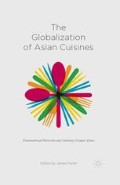Abstract
A “China Shanxi Food Festival in New York” took place on May 5–9, 2014. It opened with a food gala at the United Nations headquarters prepared by 16 chefs selected from the sixty thousand restaurants across North China’s Shanxi Province. The UN UnderSecretary-General and former Indian ambassador to China Vijay Nambiar tried his hand at making the province’s iconic knife-shaved noodles. “In many ways, cuisine and food culture are two aspects of a great civilization,” he said. “From that point of view, it’s a great and unique opportunity to be able to come here and taste the flavors of the hallmark of Chinese food culture. Today we are witnessing some of the fundamental items of Chinese cuisine, which have made it justly famous around the world.” The festival was hosted by the Shanxi Ministry of Commerce, in cooperation with provincial and national cuisine and industry associations. Other festival events were a noodle cooking performance at Manhattan’s Sun Restaurant, a Sino-US Industry seminar at the Sheraton Hotel in Flushing, Queens, and a Shanxi cooking and tasting event at New York University. The purpose of all this, according to Sun Yuejin, head of the Shanxi Ministry of Commerce, was to “help Shanxi food find its way in the world and [it] is a good way to promote its cuisine and particular characteristics and give the province a more international image” (China Daily 2014).
This research was made possible by a grant from the Japanese Society for the Promotion of Sciences, Grant No. 22402040, “Sociological Research into Culinary Soft Power and Culinary Contact Zones.” For arranging interviews at the restaurants in Shanxi I am grateful to Yao Chaocheng and thank Wang Chuanfei and Tong Liu for their research assistance.
Access this chapter
Tax calculation will be finalised at checkout
Purchases are for personal use only
Preview
Unable to display preview. Download preview PDF.
References
Ceccarini, Rossella. 2011. Pizza and Pizza Chefs in Japan: A Case of Culinary Globalization. Leiden: Brill.
China Daily, 2011. “Culture Will Be Powered Up.” November 11 online edition. Accessed April 29, 2015. http://www.chinadaily.com.cn/opinion/2011–11/03/content_14027893.htm
—. 2014. “UN Hosts Shanxi Food Festival.” May 6 online edition. Accessed February 17, 2015. http://www.chinadaily.com.cn/world/2014–05/06/content_17487064.htm
Goodman, David. 2002. “Structuring Local Identity: Nation, Province and County in Shanxi during the 1990s.” China Quarterly 127: 837–862.
—. 2006. “Shanxi as Translocal Imaginary: Reforming the Local.” In Translocal China: Linkages, Identities and the Reimagining of Space, edited by Tim Oakes and Louisa Schein, 56–73. London: Routledge.
Imai, Shoko. 2010. “Nobu and After: Westernized Japanese Food and Globalization. In Globalizing Food Consumption and the Construction of Social Identity, edited by James Farrer. Sophia University Institute of Comparative Culture. Accessed on April 25, 2015.
Krishnendu, Ray. 2012. “Global Flows, Local Bodies: Dreams of Pakistani Grill in Manhattan.” In Curried Cultures: Globalization, Food, and South Asia, edited by Ray Krishnendu and Tulasi Srinivas, 175–95. Berkeley: University of California Press.
Li, Mingjiang. 2008. “China Debates Soft Power.” The Chinese Journal of International Politics, 2, 2: 287–308. Accessed April 29, 2015. http://cjip.oxfordjournals.org/content/2/2/287.full#sec-2
Pilcher, Jeffrey M. (2012). Planet Taco: A Global History of Mexican Food. New York: Oxford University Press.
Roberts, J. A. G. 2002. China to Chinatown: Chinese Food in the West. London: Reaktion Books.
Swislocki, Mark. 2009. Culinary Nostalgia: Regional Food Culture and the Urban Experience in Shanghai. Stanford University Press: Palo Alto.
Wank, David. 2010. “Culinary Nostalgia and Chinese Neoliberalism: Local Dish Restaurants in Shanxi Province.” In Globalizing Food Consumption and the Construction of Social Identity, edited by James Farrer. Sophia University Institute of Comparative Culture. Accessed April 25, 2015. http://icc.fa.sophia.ac.jp/global%20food%20papers/pdf/2_5_WANK.pdf.
Watson, James L., (ed.). 2006 (2nd ed.). Golden Arches East: McDonald’s in East Asia. Stanford University Press.
Wu, David Y. H. and Sidney C. H. Cheung (eds.). 2002. The Globalization of Chinese Food. Honolulu: University of Hawaii Press.
Yoshino, Kosaku. 2010. “Malaysian Cuisine: A Case of Neglected Culinary Globalization.” In Globalizing Food Consumption and the Construction of Social Identity, edited by James Farrer. Sophia University Institute of Comparative Culture. Accessed April 25, 2015. http://icc.fla.sophia.ac.jp/global%20food%20papers/pdf/2_4_YOSHINO.pdf.
Zhao, Hongkui. 2008. “The Unique Charms of the Culture of Traditional Food of Jinzhong.” In Rethinking Locales in Globalization: Shanxi Province in Comparative Perspective (conference proceedings), edited by David L. Wank. Tokyo: Sophia University Towards an Area-Based Global Studies COE.
Zhihu. 2015. “Why Are There So Few Noodle Shops in Shanxi?” (Shanxi mianguan weishenma hen shao?). Accessed February 19, 2015. http://www.zhihu.com/question/24485963.
Editor information
Copyright information
© 2015 James Farrer
About this chapter
Cite this chapter
Wank, D.L. (2015). Knife-Shaved Noodles Go Global: Provincial Culinary Politics and the Improbable Rise of a Minor Chinese Cuisine. In: Farrer, J. (eds) The Globalization of Asian Cuisines. Palgrave Macmillan, New York. https://doi.org/10.1057/9781137514080_10
Download citation
DOI: https://doi.org/10.1057/9781137514080_10
Publisher Name: Palgrave Macmillan, New York
Print ISBN: 978-1-349-57567-1
Online ISBN: 978-1-137-51408-0
eBook Packages: Palgrave Media & Culture CollectionLiterature, Cultural and Media Studies (R0)

